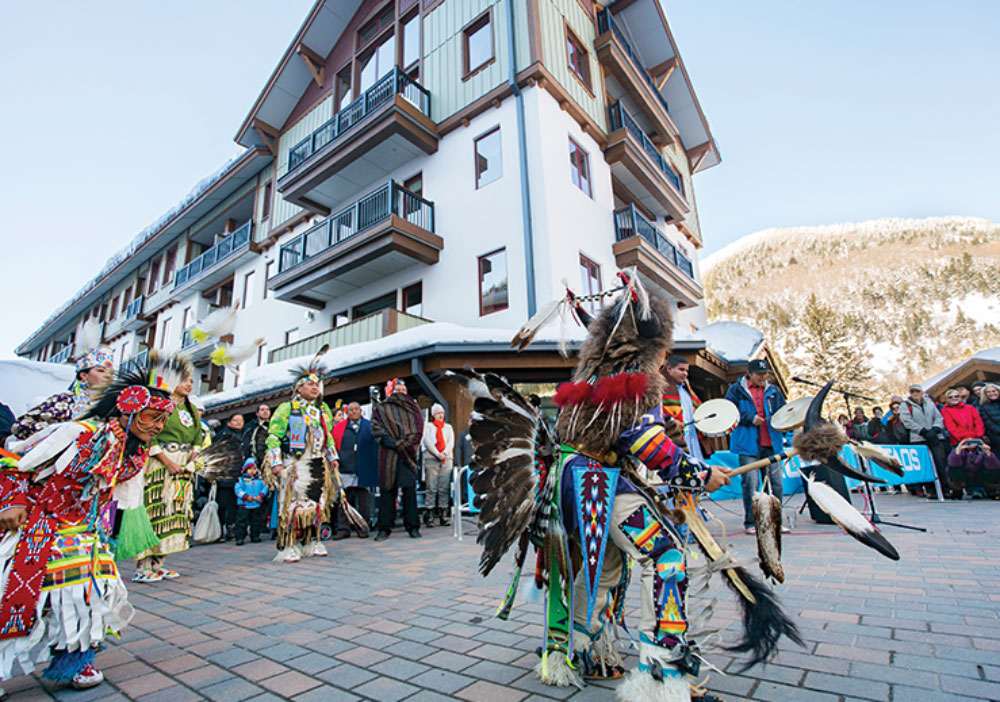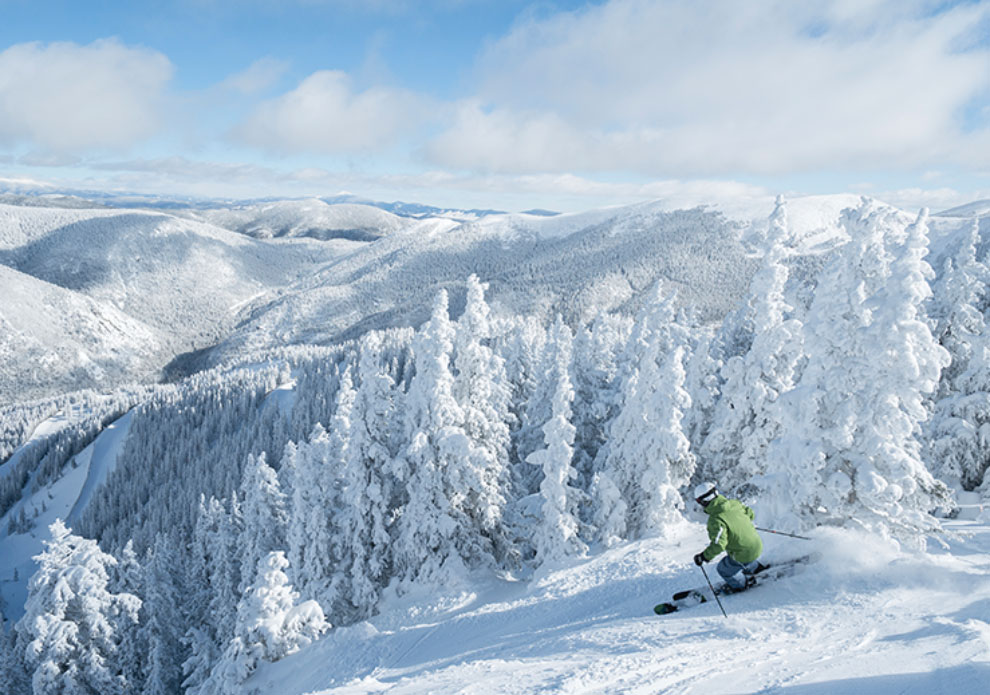In 1954, Swiss-German immigrant, Ernie Blake, his wife, Rhoda Blake and their three children moved into a camper nestled at the southern base of the Rocky Mountains in the beautiful Sangre de Cristo Mountains of New Mexico.
Eighteen miles above the historic and culturally diverse village of Taos, they founded Taos Ski Valley, and over the next sixty years, three generations of the family owned, operated and developed their vision into a world-class ski resort.
That first year, beginning at the base area, 9,207 feet above sea level, Blake cleared the first ski trail, the Snakedance. By the winter of 1955, with the help of 16 local men, the mountain’s first lift was in operation; and from there on, he never looked back.
In 1996, Taos Ski Valley became an incorporated village, the highest municipality in the U.S. and currently home to almost 150 residents. Today, with a vertical drop of more than 3,274 feet, the resort features 13 lifts and more than 100 ski trails along with extensive mountain biking and hiking trails throughout the property.
Long-time Taos Ski Valley skier, conservationist and philanthropist, Louis Bacon, saw the potential for thoughtful and sustainable development of the area, and in 2013, he purchased the resort from the Blake family. Additionally, he began the Taos Ski Valley Foundation for his charitable giving in the area.
Bacon seeks to revitalize Taos by committing to invest approximately $300 million in the resort over a 10-year period guided by three goals: create a sustainable four-season resort, improve on the mountain skiing and riding opportunities and enhance the year-round guest experience.
Starting at the top
Soaring to its summit of 12,481 feet in 2014, the new Kachina Peak Lift became one of the highest chairlifts in North America, increasing the mountain’s advanced and expert lift-serviced terrain by an amazing 50 percent.
“This summer we’ve been upgrading the back side of the mountain, the Kachina Basin area,” said Dawn Boulware, director of human resources, sustainability coordinator and officer of Taos Ski Valley, Inc. “We’re constructing a municipal water tank developed by the Village, remodelling the Phoenix Grill and have purchased the original restaurant, The Bavarian, which is now undergoing extensive renovations.”
Many improvements have been made all the way down the mountain including the replacement of two older chairlifts with fixed-grip triple chairs. In addition, the resort has been upgrading its snowmaking equipment, purchasing five low-energy HKD snow guns and upgrading to premium-
efficiency, variable-frequency electric motors and drives.
This new equipment has reduced snowmaking energy consumption by 17 percent and the water-to-snow conversion rate by 15 percent. Meanwhile, an extensive snow-farming program is also helping to deal with recent decreasing snowfall averages. Boulware adds that the trails are kept in top condition with 10 operators using PistenBully 400s to groom approximately 275 acres every night during the ski season.
To the base of it all
Last year, the resort reconfigured the beginner area, replacing two lifts with a new Skytrac fixed-grip triple chair – much better for new skiers – and a six-passenger pulse gondola for convenient travel across the area. In addition, heavy equipment smoothed out the old double-fall line and some sections normally considered too steep for beginners. Utilizing Terrain-Based Learning, where the snow is purposefully shaped to allow for an easier learning process, new skiers and riders are having more fun out on the slopes faster than ever.
One of the first big projects taken on under the new ownership was construction of the Blake Hotel. As Boulware said, “We tore down our old rental and retail shops, very old buildings that were there since the early ’70s. Once the demolition was complete, we built the Blake – the first hotel the resort has owned and operated.” Featuring hand-made textiles, native influences and art to reflect the eclectic culture of the area, the LEED Silver-certified building holds 80 guest rooms, the 192 at the Blake restaurant, a pool, hot tubs and the Spa & Wellness Center. Ground-source heating, LED lighting and many other sustainable practices are an integral part of the design.

An updated and upgraded plaza offers new day and seasonal lockers, restaurants, retail/rental facilities, ticket and pass sales, along with a beautiful river walk. Yes, this resort even has a river running through the middle.
Twenty miles downstream from Taos Ski Valley, the Rio Hondo merges into the famous Rio Grande. In cooperation with the U.S. Forest Service and the Nature Conservancy, the resort has revitalized the river as it flows through the property, integrating the main base area with the natural world.
Meanwhile, the Children’s Center is undergoing a complete remodel with a new layout, equipment outfitting area and an “adult-free” zone. Guests and school children come to the resort to take part in various programs, including the popular ski week program, while a modern daycare facility ensures that everyone has a happy, carefree day on the mountain.
There is so much going on, and all is planned and implemented within a framework of sustainability. By switching to water-based cleaners, the use of benzene products in vehicle maintenance/parts cleaning has been reduced by 75 percent, while old, dirty oil is burned in a CleanBurn heater rather than thrown out. Throughout the ski valley, only reusable dining ware is in service; disposable plastic bottles are not sold on site; LED lights are being installed wherever appropriate.
Strong ties within the community
Boulware talks about dealing with 30-year-old infrastructure and how recently, the resort has brought natural gas up into the Village of Taos Ski Valley. Through a multi-million-dollar investment, the resort installed underground fiber optics and power, improving wireless reception, telecommunications and networks throughout the area.
“Because of the remoteness of Taos, the Blake family relied on the community for staffing and forged relationships within the local business community,” said Boulware. That local community is tri-cultural: Native American of Taos Pueblo, a UNESCO World Heritage site inhabited for 1,000 years; the Hispanic influence from Spanish exploration of the 1500s, the Anglo trappers, traders, miners and art colony of the early 1900s and hippie communes of the 1960s.
”Our staff has been and continues to be diverse in ethnicity and thinking… some are the third generation of their families to work here. The interdependence of the community led to our values of inclusion, sustainability and respect.”
Using business as a Force for Good™
All these successes originated through the resort’s Taos Verde (Green Taos) Initiative with its five core areas of focus: energy efficiency, land stewardship, efficient water use, responsible waste management and community engagement. From its inception, a comprehensive environmental commitment was made to reduce overall energy consumption and greenhouse gas emission by 20 percent by 2020. Already, from 2014 to 2016, Taos Ski Valley recorded an overall reduction of 10.9 percent – that’s 340 metric tonnes of carbon dioxide not going into the atmosphere.
In recognition of its work towards sustainable slopes and positive climate change, Taos Ski Valley received the NSAA Golden Eagle Award for Environmental Excellence in 2017. In February of the same year, Taos Ski Valley became the first ski resort in the world to become a Certified B Corporation® (B Corp™) by demonstrating its commitment to deliberate and thoughtful social, economic and environmental actions.
Today there are more than 2,100 certified B Corps from 50 countries in over 130 industries – these are for-profit companies certified by the non-profit B Lab to meet rigorous standards of social and environmental performance, accountability and transparency.
As Boulware said, “David Norden, our CEO, came on in July of 2016, and he was the main driver behind us pursuing our B Corp certification. Being a part of the B Corp community allows us to learn from other B Corp businesses how to improve our business practices; how to be better. Taos is ‘B-ing’ the change we want to see in the world and especially in our industry.”
Looking towards the future, Taos Ski Valley will continue to expand across all the seasons with self-guided fee-based mountain biking trails, many hiking trails including the new Wheeler Peak trail that climbs to 13,131 feet above sea level – the highest point in New Mexico. All this has been and will be achieved within the most comprehensive forest management initiatives. At the main base area, the resort hosts cultural events, music festivals, community development programs and children’s weekend day camps.
“We’re looking forward to being a part of the renaissance of Taos,” Boulware said. “And we’re doing it in a really thoughtful and deliberate way to make sure it’s done well.”
Taos Ski Valley proves that a business can be successful in more ways than simply financial. It is an integral part of the local and the world community: an active player in a sustainable future.


![[image placeholder]](https://www.snowopsmag.com/wp-content/uploads/2023/09/placeholder@2x-890x664.png)